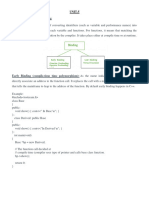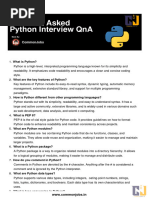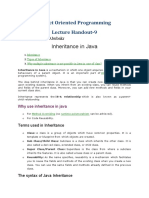Unit 6 Virtual Function, Polymorphism, and Other C++ Features
Uploaded by
tamangdorje69Unit 6 Virtual Function, Polymorphism, and Other C++ Features
Uploaded by
tamangdorje69Unit 6
Virtual Function, Polymorphism, and other C++ Features
Polymorphism
In C++, polymorphism causes a member function to behave differently based on the object
that calls/invokes it. Polymorphism is a Greek word that means to have many forms. It occurs
when you have a hierarchy of classes related through inheritance.
Types of Polymorphism
C++ supports two types of polymorphism:
1. Compile-time polymorphism, and
2. Runtime polymorphism
Fig: Types of polymorphism
Base Class Pointer
- Pointer is a data type that stores the address of other data types.
- The pointer of Base Class can point object of derived class.
1|Page Prepared By: Ramesh Kumar Chaudhary
Example:
// C++ program to illustrate the
// implementation of the base class
// pointer pointing to derived class
#include <iostream>
using namespace std;
// Base Class
class BaseClass {
public:
int var_base;
// Function to display the base
// class members
void display()
{
cout << "Displaying Base class"
<< " variable var_base: " << var_base << endl;
}
};
// Class derived from the Base Class
class DerivedClass : public BaseClass {
public:
int var_derived;
// Function to display the base
// and derived class members
void display()
{
cout << "Displaying Base class"
<< "variable var_base: " << var_base << endl;
cout << "Displaying Derived "
<< " class variable var_derived: "
<< var_derived << endl;
}
};
2|Page Prepared By: Ramesh Kumar Chaudhary
// Driver Code
int main()
{
// Pointer to base class
BaseClass* base_class_pointer;
BaseClass obj_base;
DerivedClass obj_derived;
// Pointing to derived class
base_class_pointer = &obj_derived;
base_class_pointer->var_base = 34;
// Calling base class member function
base_class_pointer->display();
base_class_pointer->var_base = 3400;
base_class_pointer->display();
DerivedClass* derived_class_pointer;
derived_class_pointer = &obj_derived;
derived_class_pointer->var_base = 9448;
derived_class_pointer->var_derived = 98;
derived_class_pointer->display();
return 0;
}
Output:
Displaying Base class variable var_base: 34
Displaying Base class variable var_base: 3400
Displaying Base classvariable var_base: 9448
Displaying Derived class variable var_derived: 98
Virtual Function
- A C++ virtual function is a member function in the base class that you redefine in a derived
class. It is declared using the virtual keyword.
- It is used to tell the compiler to perform dynamic linkage or late binding on the function.
- There is a necessity to use the single pointer to refer to all the objects of the different
classes. So, we create the pointer to the base class that refers to all the derived objects.
But, when base class pointer contains the address of the derived class object, always
executes the base class function. This issue can only be resolved by using the 'virtual'
function.
- A 'virtual' is a keyword preceding the normal declaration of a function.
- When the function is made virtual, C++ determines which function is to be invoked at the
runtime based on the type of the object pointed by the base class pointer.
3|Page Prepared By: Ramesh Kumar Chaudhary
Late binding or Dynamic linkage
In late binding function call is resolved during runtime. Therefore compiler determines the
type of object at runtime, and then binds the function call.
Rules of Virtual Function
- Virtual functions must be members of some class.
- Virtual functions cannot be static members.
- They are accessed through object pointers.
- They can be a friend of another class.
- A virtual function must be defined in the base class, even though it is not used.
- The prototypes of a virtual function of the base class and all the derived classes must be
identical. If the two functions with the same name but different prototypes, C++ will
consider them as the overloaded functions.
- We cannot have a virtual constructor, but we can have a virtual destructor
Example:
#include <iostream>
using namespace std;
class A
{
public:
virtual void display()
{
cout << "Base class is invoked"<<endl;
}
};
class B:public A
{
public:
void display()
{
cout << "Derived Class is invoked"<<endl;
}
};
int main()
{
A* a; //pointer of base class
B b; //object of derived class
a = &b;
a->display(); //Late Binding occurs
}
4|Page Prepared By: Ramesh Kumar Chaudhary
Output:
Derived Class is invoked
Pure Virtual Function
- A virtual function is not used for performing any task. It only serves as a placeholder.
- When the function has no definition, such function is known as "do-nothing" function.
- The "do-nothing" function is known as a pure virtual function. A pure virtual function is a
function declared in the base class that has no definition relative to the base class.
- A class containing the pure virtual function cannot be used to declare the objects of its
own, such classes are known as abstract base classes.
- The main objective of the base class is to provide the traits to the derived classes and to
create the base pointer used for achieving the runtime polymorphism.
Pure virtual function can be defined as:
virtual void display() = 0;
Example:
#include <iostream>
using namespace std;
class Base
{
public:
virtual void show() = 0;
};
class Derived : public Base
{
public:
void show()
{
std::cout << "Derived class is derived from the base
class." << std::endl;
}
};
int main()
{
Base *bptr;
//Base b;
Derived d;
bptr = &d;
bptr->show();
return 0;
}
Output:
Derived class is derived from the base class.
5|Page Prepared By: Ramesh Kumar Chaudhary
Abstract Class
- An abstract class is a class in C++ which have at least one pure virtual function.
- Abstract class can have normal functions and variables along with a pure virtual function.
- Abstract class cannot be instantiated, but pointers and references of Abstract class type
can be created.
- Abstract classes are mainly used for Upcasting, so that its derived classes can use its
interface.
- If an Abstract Class has derived class, they must implement all pure virtual functions, or
else they will become Abstract too.
- Abstract classes cannot be used to instantiate objects and serves only as an interface.
Example:
#include<iostream>
using namespace std;
class Base {
public:
virtual void show() = 0; // Pure Virtual Function
};
class Derived:public Base {
public:
void show() {
cout << "Virtual Function in Derived class\n";
}
};
int main() {
Base *b;
Derived dobj;
b = &dobj;
b->show();
}
Output:
Virtual Function in Derived class
Concrete Classes
Classes that can be used to instantiate objects are called concrete classes.
Virtual Destructor
Deleting a derived class object using a pointer of base class type that has a non-virtual
destructor results in undefined behaviour. To correct this situation, the base class should be
defined with a virtual destructor.
For example, following program results in undefined behaviour.
6|Page Prepared By: Ramesh Kumar Chaudhary
Example:
Without the use of virtual destructor.
// CPP program without virtual destructor
// causing undefined behavior
#include <iostream>
using namespace std;
class base {
public:
base()
{ cout << "Constructing base\n"; }
~base()
{ cout<< "Destructing base\n"; }
};
class derived: public base {
public:
derived()
{ cout << "Constructing derived\n"; }
~derived()
{ cout << "Destructing derived\n"; }
};
int main()
{
derived *d = new derived();
base *b = d;
delete b;
getchar();
return 0;
}
Output:
Constructing base
Constructing derived
Destructing base
Example:
Use of virtual destructor
// A program with virtual destructor
#include <iostream>
using namespace std;
class base {
public:
base()
{ cout << "Constructing base\n"; }
7|Page Prepared By: Ramesh Kumar Chaudhary
virtual ~base()
{ cout << "Destructing base\n"; }
};
class derived : public base {
public:
derived()
{ cout << "Constructing derived\n"; }
virtual ~derived()
{ cout << "Destructing derived\n"; }
};
int main()
{
derived *d = new derived();
base *b = d;
delete b;
getchar();
return 0;
}
Output:
Constructing base
Constructing derived
Destructing derived
Destructing base
Difference between Runtime and compile time polymorphism
Compile-Time Polymorphism Run-Time Polymorphism
Invoking of The function is invoked at the The function is invoked at the run
Function compile time. time.
Common It is known as overloading, early It is known as overriding, late binding,
Terms binding, and static binding. and dynamic binding.
Method Name In Overloading, more than one In Overriding, more than one method
and method has the same name but has the same name, number, and
Parameters with a different number or type of type of parameters.
parameters.
Carriers It is achieved with function and It is achieved with virtual functions
operator overloading. and pointers.
Execution Time It executes faster than run-time It executes slower than compile-time
polymorphism at the compile time. polymorphism at the run time.
Flexibility It is less flexible as everything It is more flexible as everything
executes at the compile time. executes at the run time.
8|Page Prepared By: Ramesh Kumar Chaudhary
You might also like
- 1Z0-808 Dumps For Guaranteed Preparation Material PDFNo ratings yet1Z0-808 Dumps For Guaranteed Preparation Material PDF10 pages
- Function Overloading vs Function Overriding in CNo ratings yetFunction Overloading vs Function Overriding in C8 pages
- Virtual Function and Pure Virtual FunctionNo ratings yetVirtual Function and Pure Virtual Function4 pages
- Unit - III (Virtual Functions) : Static BindingNo ratings yetUnit - III (Virtual Functions) : Static Binding10 pages
- Abstract Base Classes and Concrete ClassesNo ratings yetAbstract Base Classes and Concrete Classes23 pages
- EEN-103 Programming in C++: Dynamic Binding and Virtual Functions PolymorphismNo ratings yetEEN-103 Programming in C++: Dynamic Binding and Virtual Functions Polymorphism46 pages
- Fundamentals of Electrical Drives GK DubeyNo ratings yetFundamentals of Electrical Drives GK Dubey49 pages
- OBJECT ORIENTED PROGRAMMING(Polymorphism)No ratings yetOBJECT ORIENTED PROGRAMMING(Polymorphism)14 pages
- Unit-5: Darshan Institute of Engineering & Technology For Diploma StudiesNo ratings yetUnit-5: Darshan Institute of Engineering & Technology For Diploma Studies5 pages
- Assignment 04 Name:-Nazarene Semester:-3rd (2nd Year) Branch:-Computer Science EnggNo ratings yetAssignment 04 Name:-Nazarene Semester:-3rd (2nd Year) Branch:-Computer Science Engg10 pages
- Assignment-2: Name - Harsh Prajapati Registration No. - 23BCY10314No ratings yetAssignment-2: Name - Harsh Prajapati Registration No. - 23BCY103149 pages
- Object-Oriented Programming (From "Software and Mind")No ratings yetObject-Oriented Programming (From "Software and Mind")66 pages
- Pokhara University/Faculty of Science & Technology/ Revised Syllabus-2012/ Engineering62% (13)Pokhara University/Faculty of Science & Technology/ Revised Syllabus-2012/ Engineering27 pages
- (Ebook) Introduction to Java Programming. Comprehensive Version by Y. Daniel Liang ISBN 9780133761313, 0133761312 pdf download100% (2)(Ebook) Introduction to Java Programming. Comprehensive Version by Y. Daniel Liang ISBN 9780133761313, 0133761312 pdf download60 pages
- A USB Library To Detect USB Devices - CodeProjectNo ratings yetA USB Library To Detect USB Devices - CodeProject10 pages
- General + Comments + Formatting: Clean ABAPNo ratings yetGeneral + Comments + Formatting: Clean ABAP4 pages
- FMC Visualization Guidelines: Fundamental Modeling ConceptsNo ratings yetFMC Visualization Guidelines: Fundamental Modeling Concepts37 pages
- 100 Most Asked Python Interview QnA PDFNo ratings yet100 Most Asked Python Interview QnA PDF10 pages
- Chapter 16 (Oop) 1.intro Code:: Class DefNo ratings yetChapter 16 (Oop) 1.intro Code:: Class Def18 pages
- ITE 6102 - Computer Programming 1 - VC - Sept 11No ratings yetITE 6102 - Computer Programming 1 - VC - Sept 1149 pages
- MCA-108 Object Oriented Programming Using C++ L-T-P: 3-1-0No ratings yetMCA-108 Object Oriented Programming Using C++ L-T-P: 3-1-091 pages
- Inheritance in Java: Object Oriented Programming Lecture Handout-9No ratings yetInheritance in Java: Object Oriented Programming Lecture Handout-96 pages
- 1Z0-808 Dumps For Guaranteed Preparation Material PDF1Z0-808 Dumps For Guaranteed Preparation Material PDF
- EEN-103 Programming in C++: Dynamic Binding and Virtual Functions PolymorphismEEN-103 Programming in C++: Dynamic Binding and Virtual Functions Polymorphism
- Unit-5: Darshan Institute of Engineering & Technology For Diploma StudiesUnit-5: Darshan Institute of Engineering & Technology For Diploma Studies
- Assignment 04 Name:-Nazarene Semester:-3rd (2nd Year) Branch:-Computer Science EnggAssignment 04 Name:-Nazarene Semester:-3rd (2nd Year) Branch:-Computer Science Engg
- Assignment-2: Name - Harsh Prajapati Registration No. - 23BCY10314Assignment-2: Name - Harsh Prajapati Registration No. - 23BCY10314
- Object-Oriented Programming (From "Software and Mind")Object-Oriented Programming (From "Software and Mind")
- Pokhara University/Faculty of Science & Technology/ Revised Syllabus-2012/ EngineeringPokhara University/Faculty of Science & Technology/ Revised Syllabus-2012/ Engineering
- (Ebook) Introduction to Java Programming. Comprehensive Version by Y. Daniel Liang ISBN 9780133761313, 0133761312 pdf download(Ebook) Introduction to Java Programming. Comprehensive Version by Y. Daniel Liang ISBN 9780133761313, 0133761312 pdf download
- FMC Visualization Guidelines: Fundamental Modeling ConceptsFMC Visualization Guidelines: Fundamental Modeling Concepts
- MCA-108 Object Oriented Programming Using C++ L-T-P: 3-1-0MCA-108 Object Oriented Programming Using C++ L-T-P: 3-1-0
- Inheritance in Java: Object Oriented Programming Lecture Handout-9Inheritance in Java: Object Oriented Programming Lecture Handout-9

























































































